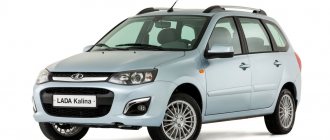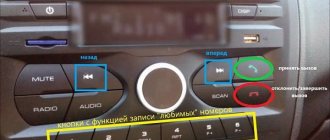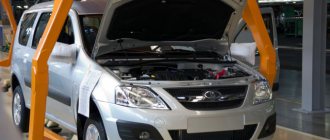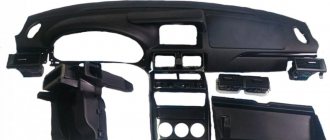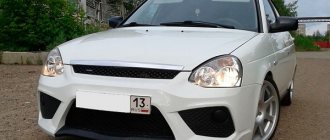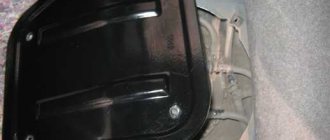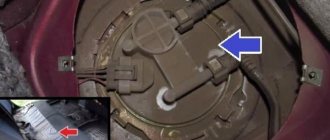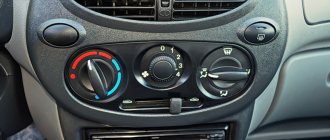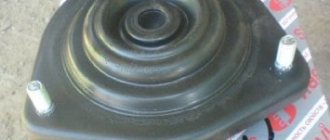It's no secret that in its standard, that is, in serial form, the engine does not develop all the power it is capable of. You can configure the firmware in a new way, but you won’t be able to significantly change the load curve without reducing the environmental class. You can buy a "racing camshaft" to install in place of the stock one. But then the firmware will have to be changed to accommodate the new phases... Let's consider what happens if we use only accessible tuning methods. Let's say right away that on the VAZ-2114 hatchback the increase in power can be 20% or even 25%, and we are talking about only 8 valves. There is no need to bore the valve channels.
Let's leave illusions in the past, and for this we watch one video.
We increase power and efficiency on the Lada Kalina
Nowadays, with rising fuel prices, there are still enthusiasts who strive to create forced engines. To increase power, additional fuel is needed, and the faster a car goes, the more fuel it needs. However, power and efficiency are not always mutually exclusive concepts. With the right parts and careful adjustments, both engine performance and fuel efficiency can be improved.
Automotive designs are full of various compromises. Automotive engineers must take into account large tolerances in the manufacturing process of components, technological capabilities, the required octane number of fuel, carbon formation, wear, lack of necessary and regular maintenance, and, at the same time, achieve the lowest possible price for the component. Standard cars and small trucks are designed to strike a balance between daily short-distance commuting within cities and high-speed highway driving. Engines and transmissions are optimized primarily for low to mid-range performance rather than high-speed performance. Engines can be thought of as air pumps that mix fuel and air and produce power through the combustion process. If something can be done that increases air flow through the engine (assuming the fuel system is able to supply enough fuel in the right proportions), then engine power is increased. Other ways to increase engine power and/or efficiency are to reduce weight, friction and load. Each engine is designed to operate at its strongest in a specific rpm range. The length and diameter of the inlet and outlet ports, intake and exhaust manifolds help determine the engine's power range. Long and small-diameter exhaust and intake manifolds improve torque at desired rpm and reduce power at high rpm. Conversely, short bores with large cross-sections improve power at high rpm. The type and flow of the intake and exhaust systems, camshaft design, valve springs and valve lifters, ignition system, cylinder heads, valve diameters, bore/stroke ratio are selected at the factory to provide a good combination of economy, power, throttle response and low concentration. exhaust gases. In addition, the transmission characteristics, final drive ratio and tire diameter must also be consistent with the movement and its characteristics.
For city driving, high torque at low and mid-range speeds (more economical) is more suitable than theoretical maximum power at high speeds. City driving engines that produce high torque over a wide rpm range provide more consistent power during shift-shift acceleration than engines that produce high peak power over a narrow rpm range. Heavy vehicles with relatively small engines must have higher transmission ratios than light vehicles with relatively large engines. Also, the engine in a heavy vehicle must be optimized for maximum torque in the low and mid-range, as it provides more torque for moving and accelerating the vehicle. New cars and trucks have low final drive ratios, lock-up torque converters, and more gears in the transmission to provide great mileage and engine response. One of the best ways to simultaneously improve performance and economy on older vehicles is to install a transmission with more forward gears and a differential with a different ratio than the standard one. Quite often, parts from later cars are suitable. Most racing engines operate in a narrow high rpm range and do not need economy and high torque at low rpm. Many manufacturers of such engines are tempted to install a special "race" camshaft or a large carburetor on a regular engine. This increases the theoretical airflow capacity without changing the flow characteristics of other parts. Since the parts are not properly matched, the incoming air speed will be reduced and the fuel will not mix properly with the air. The engine will no longer operate in its optimal speed range. This will cause the engine to choke. Torque, measured in newtons per meter (N'm), kilogram-force per meter (kgf'm), is a measure of the torque produced by an engine. Power is a measure of the work (energy) produced by the engine. Engines produce the greatest power for the given amount of fuel at their maximum torque. This corresponds to the optimal speed inherent in the engine design. Maximum power is achieved when the engine is revved above its most efficient speed. Maximum torque is always achieved at lower rpm than for maximum power. Power increases when the gains gained from increasing rpm are balanced with the losses caused by running above the optimum rpm at which the engine parts are tuned. You can tell something about an engine from its power data. On a boosted engine, maximum power will usually be higher than maximum torque, and maximum power will be achieved at relatively high rpm. As a rule, boosted engines produce approximately 1 liter. With. by 16.0 cm3. For example, a standard hypothetical engine might have a displacement of 4916 cm3, a maximum torque of 373 Nm at 3000 rpm and a power of 200 hp. With. at 4200 rpm. A forced version of the engine with the same displacement can have a torque of 330 Nm at 3800 rpm and a power of 325 hp. With. at 5600 rpm.
Before selecting parts for engine modification, you need to really imagine what you want to achieve. Before starting work, the engine must be in good condition, otherwise it will soon fail. Check the condition of the engine carefully. If necessary, make repairs; modifications can be made during repairs, which will be cheaper than doing it separately. Determine what horsepower and torque your stock engine has and at what rpm it reaches its maximum. Then determine at what speed the engine is running when the car is moving on the highway and what gear it is in. If your vehicle does not have a tachometer, temporarily connect a separate tachometer using long wires so that the tachometer can be extended into the passenger compartment. To determine the final drive ratio, read the label on the drive axle. Once this data is clarified, modification methods can be determined. Generally speaking, if you modify a vehicle to run at higher RPMs and/or make large increases in power, be prepared to sacrifice a significant amount of fuel efficiency and reliability. Some of the most popular ways to increase engine power are by turbocharging, nitrous oxide injection, or upgrading to a different engine. Special literature is devoted to each of these methods. Depending on the model and year of manufacture of the car, noticeable improvements in its performance can be achieved through careful tuning, changing the gear ratio, tire type, modifying the intake and exhaust manifolds, replacing the camshaft and improving the ignition system. Older cars are quite sensitive to such changes, which must be carefully planned and agreed upon. New computer-controlled models already have many of these changes, and such engines have better performance than their predecessors. Cars are so sensitive to change that even changing tire diameter can affect their engine response. There are very few modifications that can be made to a computer controlled vehicle without compromising emissions performance. Some specialized companies produce intake manifolds, camshafts, exhaust systems and computer "chips" that can increase the power of modern car engines. When purchasing, carefully read the instructions and determine the applicability of the computer to the engine being modified. If you are planning on rebuilding your engine, you may want to make some modifications during the rebuild. Once the engine is disassembled, the cylinder heads, pistons, connecting rods, crankshaft and camshaft can be easily replaced. Modified cylinder heads can provide a noticeable increase in power at high rpm. For engines operating in "soft" mode, high-quality valve machining at three angles and selection of intake ports to the exhaust manifold will improve engine performance without compromising its throttle response and reliability. Older engines can be improved by adding strengthened valve seats and special valves, allowing the engine to run on low-leaded and unleaded gasoline. High compression pistons improve power and efficiency at all rpms, but if the compression ratio goes above about 9:1, high octane fuel is required. Flat bottom pistons provide a better flame front in the combustion chamber than convex (concave) bottom pistons. Reinforced pistons are stiffer than cast pistons, however, cast pistons perform better under normal conditions. Longer-stroke crankshafts, coupled with matching connecting rods and larger pistons, can increase power without sacrificing throttle response and low-end torque. However, if you are aiming to build a high-revving engine, this method is unlikely to be suitable for you: long-stroke engines (long stroke) can limit the potential power at high rpm. Before assembling the engine, go to a workshop and have the parts balanced - this will help you get additional power that does not require additional fuel. Typically, if you replace one part, you must also change or replace other parts that work in conjunction with it. Check the fuel consumption as well as the vehicle's response using a stopwatch before and after each modification to determine its effectiveness. For greater accuracy of measurements, take them under the same conditions and on the same road.
Source
Malfunctions: causes, elimination
If the timing belt of the drive breaks, the 11183 motor does not bend the valve, but it has the following typical breakdowns:
| Floating speed | 1) malfunction of the ignition module 2) breakdown of the gasket 4) failure of the TPS sensor | 1) replacing the module 2) installing a new gasket 4) repairing or replacing the throttle position sensor |
| Extraneous noise | 1) misadjustment of valve clearances 2) wear of pistons | 1) adjustment with valve gaskets 2) replacement of pistons, rings 4) use of new liners |
| Alternator belt break | excessive tension, manufacturing defect | Regular check, replacement as necessary |
Since a feature of the ICE 11183 is a well-thought-out design of valves and pistons, overhauls in most cases are carried out on time without additional user investment.
TPS sensor for 11183
How to increase the power of a Kalina 8 valve engine
THEME FOR THOSE WHO WANT TO MAKE KALINA MORE DYNAMIC AT A LOW COST.
1. I decided to make my KALINKA more powerful and dynamic. Chiptuning gives an improvement, but not enough to be satisfied. I decided to move on.
2. AND SO — WE REPLACE the engine camshaft (we are talking about a 1.6 liter 8 cl. engine). For replacement, I chose the camshaft OKB "DINAMIKA" 8-266-101, which gives a power increase of 15 hp. and torque increase 16 kg/m.
3. For a new camshaft, we change the firmware for it. (but to fine-tune the firmware you need a JANUARY 7.2 controller (but not 7.2+).
All the work was carried out at the DINAMIKA Design Bureau only because of the stitching for the 101 camshaft (although mechanically I can do everything myself).
4. And so I drove it - I feel that the torque on the shaft has increased significantly at all speeds. BUT. IRON IS ONLY 50% OF SUCCESS.
I feel that the firmware for this camshaft is NOT GREAT.
JUST AS I myself have previously installed and adjusted similar camshafts on carburetor cars - and I know what they are capable of.
5. I went to PAULUS to finalize the firmware for the 101 camshaft!
GOOD FIRMWARE is the second 50% OF SUCCESS.
My KALINKA ran completely differently!!
The acceleration dynamics have become noticeably better, from the very bottom all the way up to 6000 rpm! On the road, many cars and foreign cars are also inferior to me in terms of acceleration dynamics! DRIVING BECAME MUCH MORE CONFIDENT AND CALM (psychologically I am confident in my car). )
I expected that with an increase in power, fuel consumption would increase - IT DID NOT INCREASE. (let me remind you of the PAULUS firmware - 50% success). Just recently I made a trip along the GOLDEN RING (600 km) (Vladimir, Suzdal, Gul Khrustalny), the car load was 100% - 5 people in the car and luggage.
CONSUMPTION - 5.9 l/100km. Moreover, I was driving without saving 100-120 km/h while overtaking at 140 km/h.
Now the average consumption (city-highway) is less than 7 liters.
YOUR CONSUMPTION WILL INCREASE BECAUSE THE CAR DRIVES BETTER AND YOU WANT TO PRESSURE ON THE GAS HARDER!
I AM SATISFIED WITH THE CAR.
ALL COSTS for engine tuning are less than 15 thousand rubles (of which 4 thousand rubles are for the purchase of JANUARY, all BOSCH).
ANOTHER VERY SUBTLE QUESTION! WHY I CHOOSE 101 CAMSHAFT.
1. For some reason, everyone is trying to install semi-sport camshafts (106, 107, 108, 109) which give an increase in power and torque at high speeds of 5000-7000 rpm. BUT. Such shafts have a small increase in TORQUE (or no increase at all) at LOW and MEDIUM speeds, which sometimes results in a loss with conventional camshafts during normal driving.
To drive normally (dynamically) on such shafts, you must constantly spin the engine to high speeds of 5000-7000 rpm. - and often you drive in this style - only at races.
2. THEREFORE I chose camshaft 101 which gives a noticeable increase in TORQUE from idle speed up to 5000-6000 rpm. which, during normal driving, gives a huge gain in acceleration dynamics right from the start.
Although you can race with this camshaft, I can easily argue with foreign cars with engines up to 1.8-2 liters in volume!
HUGE THANKS TO VLADIMIR GOLUBEV AND THE WORKERS OF OKB “DYNAMICS”!
Source
Maintenance
In accordance with the manufacturer's regulations, engine 11186 must be serviced in the following order:
| Maintenance object | Time (year) or mileage (1000 km), whichever comes first |
| Timing belt | 3/50 |
| battery | 1/20 |
| Valve clearances | 2/20 |
| Crankcase ventilation | 2/20 |
| Belts that drive attachments | 2/20 |
| Fuel line and tank cap | 2/40 |
| Motor oil | 1/10 |
| Oil filter) | 1/10 |
| Air filter) | 1 – 2/40 |
| Fuel filter) | 4/40 |
| Heating/Cooling Fittings and Hoses | 2/40 |
| coolant | 2/40 |
| Oxygen sensor | 100 |
| Spark plug | 1 – 2/20 |
| Exhaust manifold | 1 |
This is exactly the frequency of maintenance that the ICE 11186 device is designed for.
TUNING THE LADA KALINA STATION - WHAT TO PAY ATTENTION TO IF YOU DO IT YOURSELF
Some may think that the station wagon Kalina is not a very good candidate for deep tuning. After all, the purpose of this car is leisurely city driving, and not participation in street racing. However, there are many enthusiasts who are not satisfied with certain characteristics of their station wagons. And they start tuning them. Let's figure out how they do it.
- Tuning the Kalina engine
- Tuning of chassis and brakes
- Work on the appearance of "Kalina"
- Interior tuning
- Headlights
- Trunk and doors
Engine VAZ 11186 1.6 l
Experts consider the VAZ 11186 engine as a modernization of the 21114 engine, a secondary modification of the 21083, or an improvement in the characteristics of the 11183 internal combustion engine. The first option is considered more correct, since the design of 11186 and 21114 is absolutely identical, with the exception of the pistons. The 11186 engine is equipped with AvtoVAZ products, and the previous version of the internal combustion engine was equipped with pistons from the manufacturer Federal Mogul (USA), which developed it under a contract with the Volzhsky Automobile Plant.
TUNING THE KALINA ENGINE
The working volume of the Kalina eight-valve engine is 1600 cm³. With it, it regularly produces the power stated in the instructions. But he categorically does not want to accelerate above 5 thousand rpm without modification. Here's what it consists of:
A direct-flow exhaust system is installed on the car.
The direct-flow exhaust allows the engine to “breathe” more freely. This increases the number of revolutions by 10–15%.
Chip tuning is in progress.
This procedure allows you to increase the speed characteristics of the engine by 8–10%, increase its throttle response and improve other parameters (which ones specifically depend on the firmware selected by the driver).
Zero resistance filters are being installed.
The purpose of a zero resistance filter is to increase the amount of air entering the motor. As a result, the volume of the mixture burned in the chambers sharply increases. The cost of such a filter starts from 2 thousand rubles.
The inlet receiver is installed.
The intake receiver is installed in order to reduce the vacuum in the combustion chambers during the intake strokes, when the engine reaches high speeds.
The price of the device is from 7 thousand rubles. Installing a receiver can increase the power of the Kalina engine by 10%. And fans of extreme tuning install large-capacity sports receivers on their cars. To install them, they have to bore the throttle body to 53mm. The installation of a sports receiver is always combined with the “sports” firmware of the car. If it is not there, you can forget about stable operation of the engine.
The crankshaft is being replaced.
To supply more fuel mixture to the combustion chambers, the Kalina is equipped with a special camshaft, the cams of which have a slightly different shape and are capable of raising the valves a little higher than usual.
This measure increases engine power by 25% and significantly increases its torque. But there is a minus: fuel consumption also increases significantly.
Refinement of valves.
Lightweight T-valves are installed in the cylinder head and the valve seats are bored accordingly. The price of this operation reaches 12 thousand rubles (for 8-valve engines) and 32 thousand rubles (for 16-valve engines).
Cylinder boring.
The goal is to increase engine capacity to 1.7 liters. Performed only by a qualified turner. The price of such a service is from 12 thousand rubles. After boring, the power of the 8-valve engine increases to 132 hp. s, and 16-valve - up to 170 liters. With.
Turbocharged engine.
To do this, a turbocharger is installed on the Kalina. Garrett compressors are held in high esteem by car enthusiasts. But this pleasure is not cheap; the cost of such turbines starts from 60 thousand rubles.
Reliability, weaknesses, maintainability
Reliability
Despite the presence of serious weaknesses (more on this below), most car owners and car service technicians consider the VAZ-11186 a reliable and economical engine. According to their numerous reviews, the motor differs from its predecessors for the better.
For example, a lot of interesting things can be found in engine discussions on various forums. Thus, a car owner writes: “... the mileage is already 240,000. It doesn’t eat oil. Lew Shel 10W-40. The car works in a taxi for days.” His interlocutor Alexander expresses himself in the same tone: “... the mileage is 276,000, the engine runs powerfully and stably. True, there was a re-flashing, and one more time I changed the pump with a belt and a roller.”
The reliability of the internal combustion engine is clearly indicated by the excess of the service life. A lot of engines easily exceeded the mileage level of 200 thousand km and successfully approached 300 thousand. At the same time, no significant breakdowns were observed in the engines.
The reason for the increased service life lies in timely engine maintenance, the use of high-quality fuels and lubricants and a careful driving style.
TUNING CHASSIS AND BRAKES
The Kalina's chassis underwent major modifications at the design stage. So it is rarely subjected to deep tuning.
Basically, drivers are limited to these measures:
- Additional fasteners and support “sports” bearings of the SS20 brand are installed on the steering rack of the front suspension;
- The standard front struts are replaced with more reliable ones. Most often, racks from Plaza are installed;
- Springs with reduced pitch are installed on the suspension. This allows you to improve the car's handling;
- Kalina's standard brake discs are replaced with sports ones, the diameter of which is larger. Usually drivers install wheels from LGR or Brembo. They are more than enough to ensure safe driving in an aggressive style;
- The standard synchronizers in the gearbox are replaced with reinforced sports synchronizers. This increases the reliability of the box and extends its service life;
- a new clutch is installed. Preference is given to units with carbon, ceramic or Kevlar discs. Their wear resistance is much higher, and such a clutch can withstand enormous loads from a “pumped” engine.
Traditional methods of improvement
In the version with an electronic gas pedal, the cooling system is looped with a hose that was previously used to heat the throttle assembly. Using an additional hose, tee and clamps, a connection of a smaller diameter is mounted to vent the system. The air vent is installed as close as possible to the thermostat using a tee cut into the supply hose to the radiator.
The second end of the air outlet element is connected to the steam outlet near the RB fitting (using another tee). This modernization made it possible to achieve a stable temperature of 90-95°C when driving around the city, with the stove starting to warm up at 50°C. The costs for additional elements (refilling refrigerant, tees, clamps and 1 m of hose) amounted to about 600 rubles. It is worth noting that before the upgrade, the sensor showed the engine temperature was more than 100°C, while cold air was blowing from the stove.
modification of the SOD consists of installing a hydraulic intake on the steam outlet. To do this, a regular tube from a dropper is inserted into the steam exhaust channel with constant immersion in the coolant and touching the bottom of the tank. While cooling, the liquid will be drawn into the outlet hose according to the principle of communicating vessels, which will protect the system from the formation of air locks. Alternatively, you can combine both methods.
WORK ON THE APPEARANCE OF “KALINA”
Tuning the appearance can also be divided into several stages.
Replacement of wheel rims.
Almost all motorists remove the standard steel wheels from the Kalina and replace them with cast ones.
They are much more beautiful. But at the same time they are practically beyond repair.
After a strong blow, such a disk cracks, and all that remains is to throw it away. There is one more nuance associated with disks: experts do not recommend installing disks with a diameter exceeding 14 inches on the Kalina. Too large discs have a detrimental effect on the aerodynamics of the car and reduce braking efficiency.
Installation of body kit.
This word here means a set of bumpers, arches and sills purchased from a specialized tuning studio. Most often, Kalinas are equipped with kits from EL-Tuning, which has two advantages: a wide range and an affordable price.
Installation of spoilers and roof rails.
The driver can either purchase spoilers or make them himself. These parts can be made of plastic, carbon, polyurethane foam and other materials. At the same time, the influence of the spoiler on the aerodynamics of the station wagon body is minimal. They are needed only to improve appearance. Rails are metal strips in a plastic shell that are attached to the roof of the car. There is no need to make them yourself, since any auto parts store has a wide range of these parts.
Replacing mirrors.
Not everyone likes the standard mirrors on Kalina either. Therefore, drivers often change them to mirrors from Granta. The second option is also common - installing special overlays that completely change the appearance of standard mirrors. They are made from both chrome steel and plastic. Sold at tuning studios. Cost - from 700 rubles.
Replacing door handles.
The standard handles on the Kalina are plastic, and it’s difficult to call them beautiful. Drivers replace them with more presentable handles, deeply recessed into the door. Most often they are painted to match the body color. But they also come in chrome, a set of which costs from 3 thousand rubles.
INTERIOR TUNING
Car owners also make a lot of changes to the Kalina’s interior.
Replacement of upholstery.
The standard interior trim in Kalina is a combination of plastic inserts and leatherette.
Many tuning enthusiasts remove the tabs and replace them with leatherette. Connoisseurs of comfort also get rid of leatherette, replacing it with velor or carpet. These materials can transform the interior, but they cannot be called durable.
Genuine leather is also used for finishing. But this option is only available to very wealthy drivers, so it is extremely rare.
Replacing seats.
When a car undergoes deep tuning, it rarely happens without replacing the standard seats with sports ones. They are more suitable for the aggressive driving style for which the car is being prepared. Anatomical Kalina-Sport seats with high headrests and back support are in great demand. The cost of one such seat is from 7 thousand rubles.
Dashboard and steering wheel trim.
To add individuality to the dashboard, Kalina owners usually use vinyl film.
Film painted to look like carbon is in particular demand. It looks very stylish on the dashboard. But there is also a minus - after 5 years, even the highest quality vinyl film becomes unusable.
As for the steering braid, you can purchase it at any specialized store. The range of braids is now very wide.
Additional interior lighting.
For illumination, various LED strips are used, connected to the vehicle’s on-board network. The cost of one such tape is from 400 rubles. Most often, additional lighting is installed on the floor of the car. Its purpose is not only aesthetic, but also practical: if the driver drops some small item on the floor of the cabin, it will not be difficult to find it. Drivers also illuminate the door handles inside the cabin using the same diode strips. This is a relatively new direction in tuning, which is quickly gaining popularity.
The standard headlights on Kalina are equipped with optics from BOSCH, and they work well. Here's what those who still want to change something in the lighting system do:
- replacement of optics in headlights. To replace the “native” optics, optical kits with white xenon illumination are installed, which are freely sold in almost all spare parts stores. But when installing such a kit, the driver must remember: he does this at his own peril and risk.
These headlights produce a very powerful luminous flux that can blind oncoming drivers. And the traffic police officers really don’t like this. This is why many car owners slightly dim the backlight using special sprays;
Maintenance
The gas distribution mechanism is driven by a belt, which requires replacement every 45 thousand km. mileage In addition, valve clearances also require periodic adjustment.
A significant advantage of the VAZ 11183 engine is that if the drive belt breaks, hard contact of the valve with the piston surface is eliminated (the valves do not bend).
Maintenance that ensures long-term operation of the power unit comes down to:
- regularly inspect the engine to detect oil and coolant leaks. If any defects are identified, they must be eliminated;
- timely replacement of engine oil - every 15,000 km.
TRUNK AND DOORS
There is also room for improvement in the doors and trunk of the Kalina.
Trunk light.
The standard luggage compartment lighting in Kalina has never been particularly bright. Drivers solve this problem either by replacing the standard light bulbs with more powerful ones, or by installing LED lighting on the luggage rack.
Audio system installation.
Music lovers often place speakers and a large subwoofer in the trunk to more accurately reproduce low frequencies.
But after installing such a system, nothing else will fit in the trunk.
So this tuning option is suitable only for real music lovers. Many people try to compensate for the lack of space in the trunk by installing a luggage box on the roof of the car. But this is a big mistake. Additional luggage space appears, but all efforts to tune the car go to waste. The box literally “presses” the car to the ground. An optical illusion occurs, and it seems that the car has become much lower.
Replacing door cards.
Standard door trim panels can be replaced with more presentable and beautiful ones. Door cards are also changed when powerful speakers are installed in the doors. In this case, the panels will have to be seriously modified by cutting additional holes in them. Be that as it may, there is no shortage of door cards today. In the store you can purchase a set for every taste, color and budget.
Source
Eliminating air pockets in the radiator
Since the system in question is absolutely sealed, getting rid of air is not so easy. The car must be placed on any inclined surface with the front facing up (the steeper, the more effective). You should warm up the power unit until the second circulation circle opens, move the temperature regulator to the maximum position, direct the air flow into the cabin and activate the fan at second speed. Next, increasing the engine speed to 4.5-5 thousand, we hold it for some time.
Then the pedal is released until the idle speed appears. If the problem is not completely resolved, the procedure should be repeated.
Despite the fact that modern domestic cars have updated characteristics, some factory defects are still present. Modification of the cooling system on the Lada Kalina is available in several ways and helps to avoid the formation of air locks. Moreover, the procedure does not require significant financial investment.
